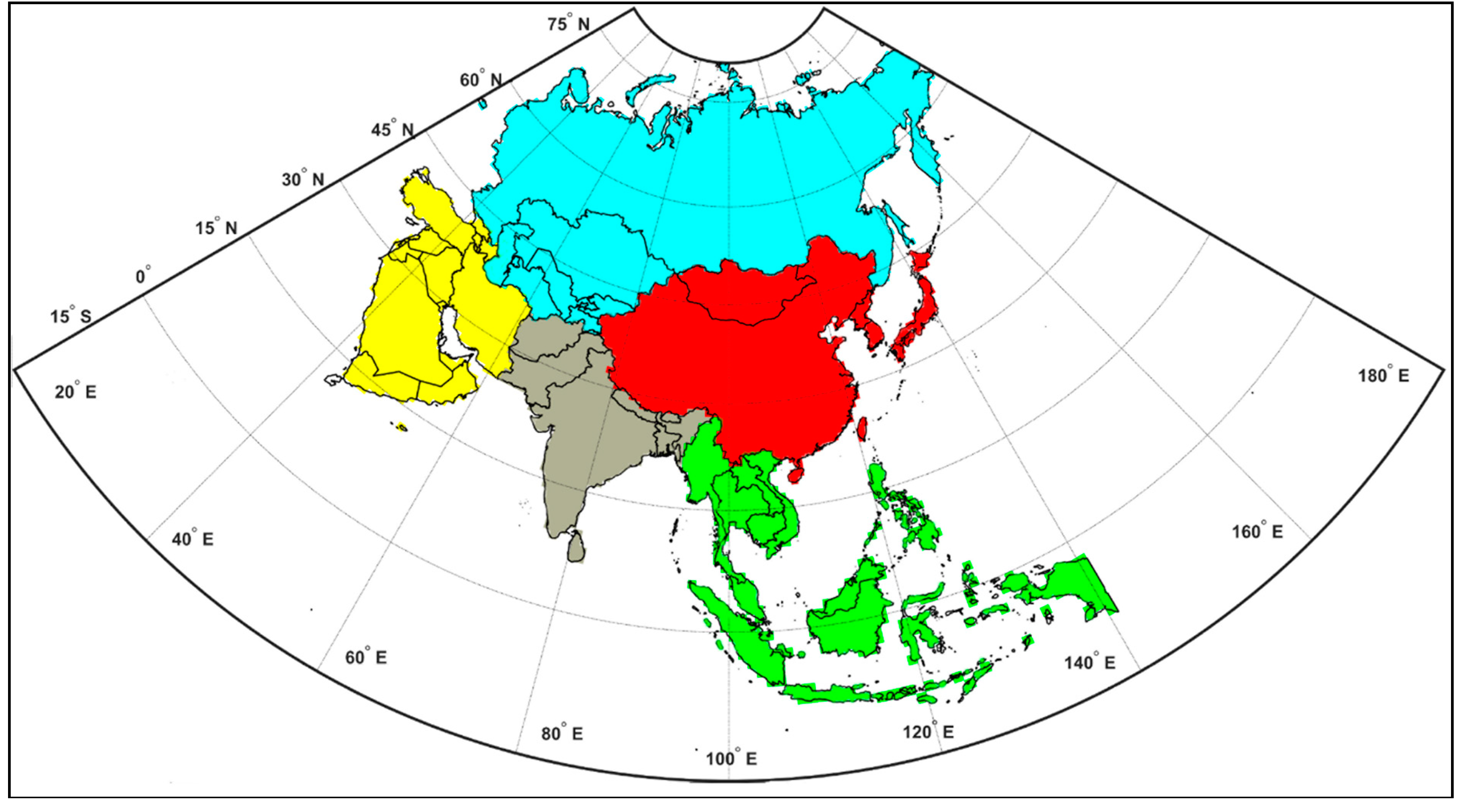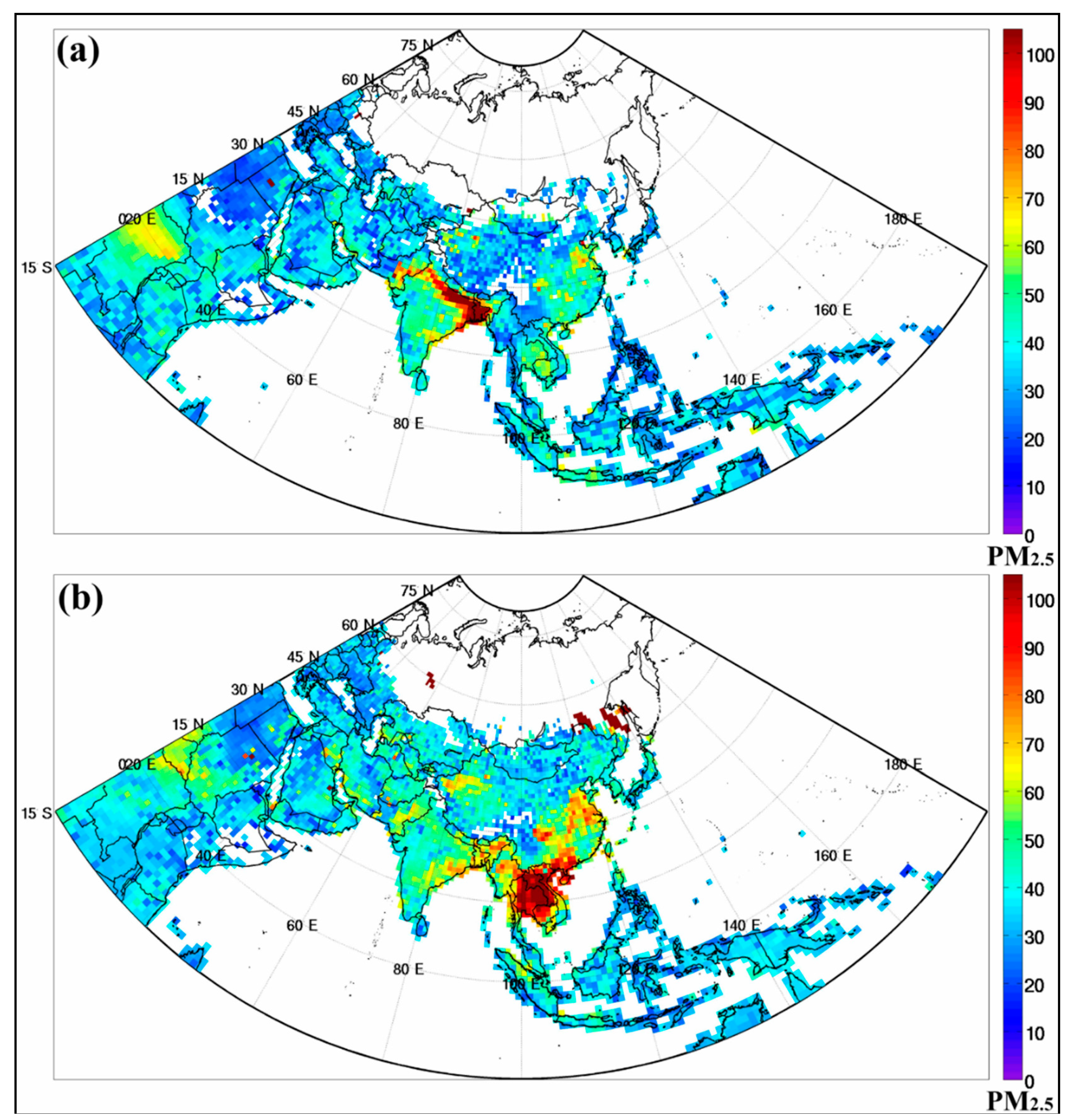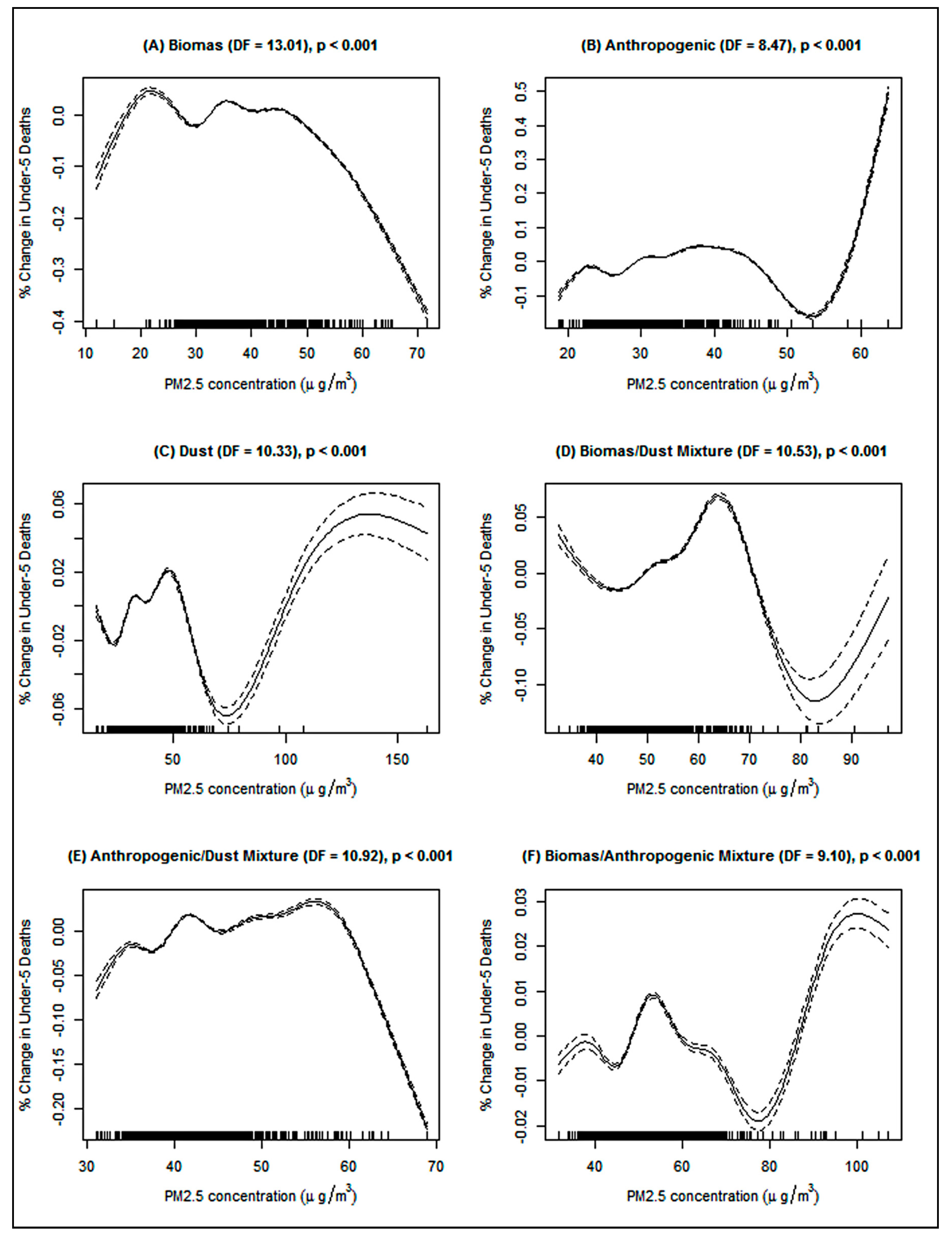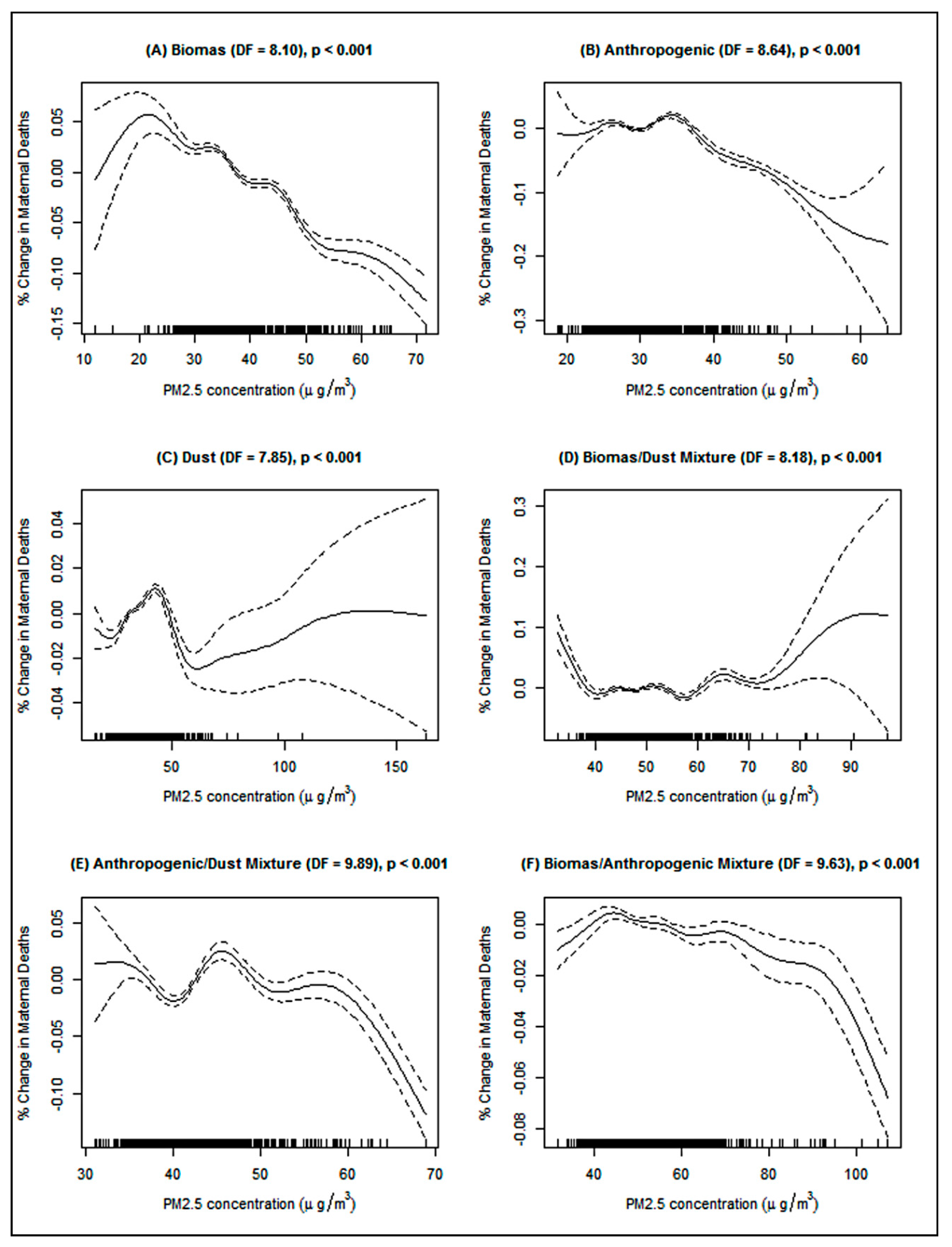Ambient Particulate Matter Exposure and Under-Five and Maternal Deaths in Asia
Abstract
1. Introduction
2. Methods
2.1. Spatial Domain
2.2. Under-Five and Maternal Mortality
2.3. Ambient PM2.5 Concentration
2.4. Covariates
2.5. Statistical Analysis
3. Results
4. Discussion
Limitations and Strengths
5. Conclusions
Supplementary Materials
Author Contributions
Funding
Conflicts of Interest
References
- World Health Organization Burden of Disease from the Joint Effects of Household and Ambient Air Pollution for 2012. Available online: http://www.who.int/phe/health_topics/outdoorair/databases/AP_jointeffect_BoD_results_March2014.pdf?ua=1 (accessed on 17 August 2017).
- Lin, Y.K.; Chen, C.F.; Yeh, H.C.; Wang, Y.C. Emergency room visits associated with particulate concentration and Asian dust storms in metropolitan Taipei. J. Expo. Sci. Environ. Epidemiol. 2016, 26, 189–196. [Google Scholar] [CrossRef] [PubMed]
- DeFranco, E.; Hall, E.; Hossain, M.; Chen, A.; Haynes, E.N.; Jones, D.; Ren, S.; Lu, L.; Muglia, L. Air pollution and stillbirth risk: Exposure to airborne particulate matter during pregnancy is associated with fetal death. PLoS ONE 2015, 10, e0120594. [Google Scholar] [CrossRef] [PubMed]
- Yorifuji, T.; Kashima, S.; Doi, H. Associations of acute exposure to fine and coarse particulate matter and mortality among older people in Tokyo, Japan. Sci. Total Environ. 2016, 542, 354–359. [Google Scholar] [CrossRef] [PubMed]
- Atkinson, R.W.; Kang, S.; Anderson, H.R.; Mills, I.C.; Walton, H.A. Epidemiological time series studies of PM2.5 and daily mortality and hospital admissions: A systematic review and meta-analysis. Thorax 2014, 69, 660–665. [Google Scholar] [CrossRef] [PubMed]
- Zheng, X.Y.; Ding, H.; Jiang, L.N.; Chen, S.W.; Zheng, J.P.; Qiu, M.; Zhou, Y.X.; Chen, Q.; Guan, W.J. Association between Air Pollutants and Asthma Emergency Room Visits and Hospital Admissions in Time Series Studies: A Systematic Review and Meta-Analysis. PLoS ONE 2015, 10, e0138146. [Google Scholar] [CrossRef] [PubMed]
- Owili, P.; Lien, W.-H.; Muga, M.; Lin, T.-H. The Associations between Types of Ambient PM2.5 and Under-Five and Maternal Mortality in Africa. Int. J. Environ. Res. Public Health 2017, 14, 359. [Google Scholar] [CrossRef] [PubMed]
- Burnett, R.T.; Pope, C.A., 3rd; Ezzati, M.; Olives, C.; Lim, S.S.; Mehta, S.; Shin, H.H.; Singh, G.; Hubbell, B.; Brauer, M.; et al. An integrated risk function for estimating the global burden of disease attributable to ambient fine particulate matter exposure. Environ. Health Perspect. 2014, 122, 397–403. [Google Scholar] [CrossRef]
- World Health Organization Ambient Air Pollution: A Global Assessment of Exposure and Burden of Disease. Available online: http://apps.who.int/iris/bitstream/10665/250141/1/9789241511353−eng.pdf (accessed on 13 March 2017).
- United Nations Sustainable Development Goals. Available online: http://www.un.org/sustainabledevelopment/ (accessed on 31 May 2016).
- World Health Organization Global Health Observatory Data: Under-Five Mortality. Available online: http://www.who.int/gho/child_health/mortality/mortality_under_five_text/en/ (accessed on 2 September 2017).
- World Health Organization [Media Centre] Maternal Mortality. Available online: http://www.who.int/mediacentre/factsheets/fs348/en/ (accessed on 28 September 2016).
- World Bank World Development Indicators. Available online: http://databank.worldbank.org/data/home.aspx (accessed on 17 October 2016).
- Hubanks, P.A.; King, M.D.; Platnick, S.; Pincus, R. MODIS Atmosphere L3 Gridded Product Algorithm Theoretical Basis Document. Available online: https://modis−images.gsfc.nasa.gov/_docs/L3_ATBD_2008_12_04.pdf (accessed on 17 August 2017).
- Levy, R.; Hsu, C. MODIS Atmosphere L2 Aerosol Product: NASA MODIS Adaptive Processing System. Available online: http://dx.doi.org/10.5067/MODIS/MOD04_L2.006 (accessed on 18 April 2017).
- Lin, T.-H.; Liu, G.-R.; Liu, C.-Y. A novel index for atmospheric aerosol type categorization with spectral optical depths from satellite retrieval. Int. Arch. Photogram. Remote Sens. Spat. Inf. Sci. 2016, XLI-B8, 277–279. [Google Scholar] [CrossRef]
- Anderson, B.G.; Bell, M.L. Weather-related mortality: How heat, cold, and heat waves affect mortality in the United States. Epidemiology 2009, 20, 205–213. [Google Scholar] [CrossRef]
- Baccini, M.; Biggeri, A.; Accetta, G.; Kosatsky, T.; Katsouyanni, K.; Analitis, A.; Anderson, H.R.; Bisanti, L.; D’Ippoliti, D.; Danova, J.; et al. Heat effects on mortality in 15 European cities. Epidemiology 2008, 19, 711–719. [Google Scholar] [CrossRef]
- Chen, R.; Yin, P.; Wang, L.; Liu, C.; Niu, Y.; Wang, W.; Jiang, Y.; Liu, Y.; Liu, J.; Qi, J.; et al. Association between ambient temperature and mortality risk and burden: Time series study in 272 main Chinese cities. BMJ 2018, 363, k4306. [Google Scholar] [CrossRef] [PubMed]
- Wang, J.; Ogawa, S. Effects of Meteorological Conditions on PM2.5 Concentrations in Nagasaki, Japan. Int. J. Environ. Res. Public Health 2015, 12, 9089–9101. [Google Scholar] [CrossRef] [PubMed]
- Balasubramanian, R.; Gao, X.; Hatakeyama, S.; Hwang, J.; Tsai, C.-J. Overview of the Special Issue “PM2.5 in Asia” for 2015 Asian Aerosol Conference. Aerosol Air Qual. Res. 2017, 17, 351–355. [Google Scholar] [CrossRef]
- Apte, J.S.; Marshall, J.D.; Cohen, A.J.; Brauer, M. Addressing Global Mortality from Ambient PM2.5. Environ. Sci. Technol. 2015, 49, 8057–8066. [Google Scholar] [CrossRef] [PubMed]
- Kloog, I.; Ridgway, B.; Koutrakis, P.; Coull, B.A.; Schwartz, J.D. Long- and short-term exposure to PM2.5 and mortality: Using novel exposure models. Epidemiology 2013, 24, 555–561. [Google Scholar] [CrossRef] [PubMed]
- Shi, L.; Zanobetti, A.; Kloog, I.; Coull, B.A.; Koutrakis, P.; Melly, S.J.; Schwartz, J.D. Low-Concentration PM2.5 and Mortality: Estimating Acute and Chronic Effects in a Population-Based Study. Environ. Health Perspect. 2016, 124, 46–52. [Google Scholar] [CrossRef] [PubMed]
- World Health Organization; Occupational and Environmental Health Team. Who Air Quality Guidelines for Particulate Matter, Ozone, Nitrogen Dioxide and Sulfur Dioxide: Global Update 2005: Summary of Risk Assessment; World Health Organization: Geneva, Switzerland, 2006; p. 20. [Google Scholar]
- Mayol−Bracero, O.L.; Gabriel, R.; Andreae, M.O.; Kirchstetter, T.W.; Novakov, T.; Ogren, J.; Sheridan, P.; Streets, D.G. Carbonaceous aerosols over the Indian Ocean during the Indian Ocean Experiment (INDOEX): Chemical characterization, optical properties, and probable sources. J. Geophys. Res. 2002, 107, 8030. [Google Scholar] [CrossRef]
- Novakov, T.; Andreae, M.O.; Gabriel, R.; Kirchstetter, T.W.; Mayol−Bracero, O.L.; Ramanathan, V. Origin of carbonaceous aerosols over the tropical Indian Ocean: Biomass burning or fossil fuels? Geophys. Res. Lett. 2000, 27, 4061–4064. [Google Scholar] [CrossRef]
- Adhikary, B.; Carmichael, G.R.; Tang, Y.; Leung, L.R.; Qian, Y.; Schauer, J.J.; Stone, E.A.; Ramanathan, V.; Ramana, M.V. Characterization of the seasonal cycle of south Asian aerosols: A regional-scale modeling analysis. J. Geophys. Res. Atmos. 2007, 112. [Google Scholar] [CrossRef]
- Jacobson, M.Z. Strong radiative heating due to the mixing state of black carbon in atmospheric aerosols. Nature 2001, 409, 695. [Google Scholar] [CrossRef]
- Hsu, N.C.; Herman, J.R.; Tsay, S.-C. Radiative impacts from biomass burning in the presence of clouds during boreal spring in southeast Asia. Geophys. Res. Lett. 2003, 30. [Google Scholar] [CrossRef]
- Kondo, Y.; Morino, Y.; Takegawa, N.; Koike, M.; Kita, K.; Miyazaki, Y.; Sachse, G.W.; Vay, S.A.; Avery, M.A.; Flocke, F.; et al. Impacts of biomass burning in Southeast Asia on ozone and reactive nitrogen over the western Pacific in spring. J. Geophys. Res. Atmos. 2004, 109. [Google Scholar] [CrossRef]
- Tsay, S.-C.; Hsu, N.C.; Lau, W.K.M.; Li, C.; Gabriel, P.M.; Ji, Q.; Holben, B.N.; Judd Welton, E.; Nguyen, A.X.; Janjai, S.; et al. From BASE-ASIA toward 7-SEAS: A satellite-surface perspective of boreal spring biomass-burning aerosols and clouds in Southeast Asia. Atmos. Environ. 2013, 78, 20–34. [Google Scholar] [CrossRef]
- Wong, C.M.; Lai, H.K.; Tsang, H.; Thach, T.Q.; Thomas, G.N.; Lam, K.B.; Chan, K.P.; Yang, L.; Lau, A.K.; Ayres, J.G.; et al. Satellite-Based Estimates of Long-Term Exposure to Fine Particles and Association with Mortality in Elderly Hong Kong Residents. Environ. Health Perspect. 2015, 123, 1167–1172. [Google Scholar] [CrossRef] [PubMed]
- Rhind, S.M. Anthropogenic pollutants: A threat to ecosystem sustainability? Philos Trans. R Soc. Lond B Biol. Sci. 2009, 364, 3391–3401. [Google Scholar] [CrossRef] [PubMed]
- World Health Organization Media Centre Ambient (Outdoor) Air Quality and Health. Available online: http://www.who.int/mediacentre/factsheets/fs313/en/ (accessed on 23 December 2016).
- Lee, H.C.; Lin, T.H. Air Pollution Particular Matter and Atherosclerosis. Acta Cardiol. Sin. 2017, 33, 646–647. [Google Scholar] [PubMed]
- Suwa, T.; Hogg, J.C.; Quinlan, K.B.; Ohgami, A.; Vincent, R.; van Eeden, S.F. Particulate air pollution induces progression of atherosclerosis. J. Am. Coll. Cardiol. 2002, 39, 935–942. [Google Scholar] [CrossRef]
- Yue, W.; Schneider, A.; Stolzel, M.; Ruckerl, R.; Cyrys, J.; Pan, X.; Zareba, W.; Koenig, W.; Wichmann, H.E.; Peters, A. Ambient source-specific particles are associated with prolonged repolarization and increased levels of inflammation in male coronary artery disease patients. Mutat. Res. 2007, 621, 50–60. [Google Scholar] [CrossRef]
- Brook, R.D.; Urch, B.; Dvonch, J.T.; Bard, R.L.; Speck, M.; Keeler, G.; Morishita, M.; Marsik, F.J.; Kamal, A.S.; Kaciroti, N.; et al. Insights into the mechanisms and mediators of the effects of air pollution exposure on blood pressure and vascular function in healthy humans. Hypertension 2009, 54, 659–667. [Google Scholar] [CrossRef]




| East Asia | Central/North Asia | West Asia | South Asia | Southeast Asia | p-Value a | ||
|---|---|---|---|---|---|---|---|
| Annual Mean (SD) | Annual Mean (SD) | Annual Mean (SD) | Annual Mean (SD) | Annual Mean (SD) | |||
| Under-5 deaths, n | 73,791.6 (149,993.4) | 14,375.2 (9,801.0) | 11,758.1 (16,626.0) | 330,969.9 (605,291.9) | 38,592.6 (52,828.0) | <0.001 | |
| Maternal deaths, n | 1445.5 (2708.6) | 193.7 (185.1) | 357.7 (812.1) | 12,617.7 (23,035.4) | 1,622.32 (2672.2) | <0.001 | |
| Biomass | |||||||
| AOD, τ | 0.29 (0.07) | 0.25 (0.06) | 0.30 (0.11) | 0.30 (0.08) | 0.35 (0.10) | <0.001 | |
| PM2.5; Jan-Dec, μg/m3 | 37.84 (6.12) | 32.76 (3.54) | 35.51 (7.99) | 38.54 (6.32) | 42.71 (8.08) | <0.001 | |
| Anthropogenic | |||||||
| AOD, τ | 0.37 (0.10) | 0.30 (0.06) | 0.32 (0.12) | 0.40 (0.11) | 0.35 (0.07) | 0.024 | |
| PM2.5; Jan-Dec, μg/m3 | 32.19 (5.40) | 28.24 (2.99) | 29.53 (6.20) | 33.52 (5.92) | 31.10 (3.91) | 0.009 | |
| Dust | |||||||
| AOD, τ | 0.48 (0.35) | 0.45 (0.26) | 0.40 (0.11) | 0.48 (0.15) | 0.51 (0.17) | 0.008 | |
| PM2.5; Jan-Dec, μg/m3 | 36.94 (17.54) | 35.50 (12.53) | 32.26 (5.72) | 36.50 (7.68) | 37.88 (8.81) | 0.024 | |
| Biomass/Dust Mixture | |||||||
| AOD, τ | 0.28 (0.06) | 0.33 (0.08) | 0.37 (0.14) | 0.38 (0.12) | 0.32 (0.08) | 0.040 | |
| PM2.5; Jan-Dec, μg/m3 | 45.15 (4.26) | 47.14 (4.50) | 49.97 (9.15) | 51.64 (7.39) | 48.71 (5.58) | <0.001 | |
| Anthropogenic/Dust Mixture | |||||||
| AOD, τ | 0.39 (0.09) | 0.35 (0.07) | 0.36 (0.10) | 0.48 (0.14) | 0.37 (0.09) | 0.006 | |
| PM2.5; Jan-Dec, μg/m3 | 42.67 (5.02) | 40.52 (3.56) | 40.92 (5.03) | 47.76 (7.39) | 41.74 (4.60) | 0.004 | |
| Biomass/Anthropogenic Mixture | |||||||
| AOD, τ | 0.41 (0.15) | 0.28 (0.08) | 0.36 (0.16) | 0.42 (0.14) | 0.48 (0.21) | <0.001 | |
| PM2.5; Jan-Dec, μg/m3 | 53.74 (9.64) | 45.34 (5.26) | 49.56 (9.25) | 53.37 (8.10) | 57.76 (13.24) | <0.001 | |
| Total population, million | 291.0 (498.0) | 37.6 (50.4) | 22.6 (28.4) | 188.0 (368.0) | 54.7 (64.3) | <0.001 | |
| Urban population, million | 146.0 (224.0) | 22.9 (37.0) | 13.9 (16.6) | 57.2 (111.0) | 23.4 (30.5) | <0.001 | |
| Female population, % | 50.15 (1.07) | 51.01 (1.38) | 44.96 (7.15) | 49.05 (1.33) | 49.94 (0.98) | 0.473 | |
| Employed population, % | 63.59 (7.54) | 58.42 (4.14) | 52.36 (14.01) | 59.31 (11.52) | 65.92 (10.47) | <0.001 | |
| AIDS death, thousand | 12.3 (10.2) | 3.2 (3.9) | 4.1 (2.8) | 3.3 (4.8) | 9.3 (10.8) | 0.788 | |
| Tuberculosis death rate, per 100,000 | 16.27 (26.86) | 15.91 (6.76) | 2.91 (5.07) | 32.23 (23.03) | 40.42 (36.64) | <0.001 | |
| Undernourished population, million | 42.0 (73.20) | 4.9 (5.0) | 6.0 (3.3) | 35.0 (64.3) | 10.4 (10.0) | 0.049 | |
| Anemia in pregnancy, % | 27.43 (3.96) | 31.66 (4.36) | 31.41 (5.14) | 43.89 (8.42) | 34.74 (7.98) | <0.001 | |
| Annual mean temperature, °C | 9.46 (5.45) | 8.06 (7.25) | 22.09 (4.82) | 20.30 (5.77) | 24.21 (3.27) | <0.001 | |
| Variable | Unadjusted GLMM, IRR (95% CI) b | ||
|---|---|---|---|
| Under-5 Deaths | Maternal Deaths | ||
| Type of PM2.5 a | |||
| Biomass | 1.45 (1.44, 1.45) *** | 1.24 (1.23, 1.24) *** | |
| Anthropogenic | 0.84 (0.77, 0.93) *** | 2.65 (2.65, 2.65) *** | |
| Dust | 2.58 (2.57, 2.59) *** | 3.55 (3.54, 3.56) *** | |
| Biomass/Dust | 8.43 (7.98, 8.91) *** | 3.16 (3.15, 3.16) *** | |
| Anthropogenic/Dust | 0.92 (0.83, 1.01) | 1.07 (1.02, 1.12) ** | |
| Biomass/Anthropogenic | 2.29 (2.27, 2.30) *** | 2.04 (2.03, 2.05) *** | |
| Sub-regions (ref: East Asia) | |||
| Central/North Asia | 1.12 (0.11, 11.62) | 0.58 (0.05, 6.27) | |
| West Asia | 3.03 (0.04, 2.29) | 0.29 (0.04, 2.27) | |
| South Asia | 3.58 (0.39, 32.84) | 6.68 (0.71, 62.55) | |
| Southeast Asia | 1.15 (0.14, 9.37) | 1.86 (0.22, 15.48) | |
| Year | 0.44 (0.43, 0.44) *** | 0.39 (0.39, 0.39) *** | |
| Total population | 0.001 (0.001, 0.001) *** | 0.21 (0.01, 0.78) | |
| Urban population | 1.20 (1.12, 1.29) *** | 1.27 (1.19, 1.36) *** | |
| Female population | 2.20 (2.08, 2.34) *** | 2.06 (2.02, 2.10) *** | |
| Employed population | 0.86 (0.85, 0.86) *** | 0.59 (0.59, 0.59) *** | |
| AIDS death | 0.08 (0.07, 0.08) *** | 0.07 (0.07, 0.07) *** | |
| Tuberculosis death | 7.59 (7.54, 7.65) *** | 11.82 (11.79, 11.85) *** | |
| Undernourished population | 1.17 (1.11, 1.22) *** | 1.20 (1.16, 1.24) *** | |
| Anemia in pregnancy | 13.92 (6.11, 31.72) *** | 30.76 (12.24, 77.29) *** | |
| Annual mean temperature | 2.55 (2.53, 2.57) *** | 4.56 (4.54, 4.59) *** | |
| Under-5 Deaths, Adjusted Model | Maternal Deaths, Adjusted Model | ||||
|---|---|---|---|---|---|
| Annual Mean PM2.5 a | GLMM + NS IRR (95% CI) b,c | GAMM + NS Coef. (Se) b | GLMM + NS IRR (95% CI) b,c | GAMM + NS Coef. (Se) b | |
| Asia Overall | |||||
| Biomass | 1.29 (1.13, 1.47) **** | −0.20 (0.003) **** | 1.09 (1.08, 1.10) **** | −0.25 (0.01) **** | |
| Anthropogenic | 1.12 (1.01, 1.24) ** | 0.03 (0.004) **** | 1.02 (0.97, 1.08) | −0.18 (0.001) **** | |
| Dust | 0.89 (0.77, 1.04) | 0.04 (0.003) **** | 1.00 (0.99, 1.00) | 0.07 (0.01) **** | |
| Biomass/Dust | 0.95 (0.85, 1.05) | 0.07 (0.003) **** | 1.64 (1.63, 1.65) **** | 0.03 (0.01) **** | |
| Anthropogenic/Dust | 1.08 (0.95, 1.23) | −0.04 (0.003) **** | 1.22 (1.19, 1.26) **** | −0.08 (0.01) **** | |
| Biomass/Anthropogenic | 1.05 (0.99, 1.11) * | 0.004 (0.002) ** | 1.00 (0.99, 1.01) | −0.04 (0.01) **** | |
| SUB−REGIONS | |||||
| East Asia | |||||
| Biomass | 1.02 (1.01, 1.03) ** | 0.02 (0.004) **** | 1.01 (0.99, 1.03) | 0.01 (0.01) | |
| Anthropogenic | 1.01 (0.99, 1.04) | 0.03 (0.005) **** | 0.99 (0.96, 1.02) | −0.002 (0.02) | |
| Dust | 0.98 (0.95, 1.01) | −0.03 (0.006) **** | 1.01 (0.97, 1.04) | 0.01 (0.02) | |
| Biomass/Dust | 1.00 (0.96, 1.03) | −0.001 (0.001) | 0.96 (0.93, 1.01) | −0.05 (0.02) ** | |
| Anthropogenic/Dust | 0.96 (0.94, 0.98) *** | −0.02 (0.007) *** | 1.01 (0.97, 1.05) | −0.003 (0.02) | |
| Biomass/Anthropogenic | 1.01 (1.00, 1.02) * | −0.02 (0.004) **** | 0.99 (0.97, 1.02) | −0.001 (0.01) | |
| Central/North Asia | |||||
| Biomass | 0.99 (0.99, 1.00) | 0.004 (0.005) | 1.07 (1.02, 1.13) ** | 0.07 (0.03) ** | |
| Anthropogenic | 1.00 (0.99, 1.01) | −0.01 (0.005) ** | 1.01 (0.94, 1.08) | −0.02 (0.04) | |
| Dust | 1.01 (1.00, 1.01) ** | 0.11 (0.008) **** | 1.03 (0.97, 1.10) | 0.07 (0.03) ** | |
| Biomass/Dust | 1.00 (0.99, 1.01) | 0.03 (0.007) **** | 1.05 (0.96, 1.16) | 0.05 (0.05) | |
| Anthropogenic/Dust | 1.00 (0.99, 1.01) | 0.003 (0.006) | 1.08 (1.00, 1.18) * | 0.08 (0.04) * | |
| Biomass/Anthropogenic | 0.99 (0.99, 0.99) *** | −0.04 (0.005) **** | 0.96 (0.91, 1.02) | −0.04 (0.03) | |
| West Asia | |||||
| Biomass | 1.01 (0.99, 1.01) | −0.06 (0.004) **** | 0.99 (0.96, 1.03) | −0.01 (0.02) | |
| Anthropogenic | 1.02 (1.01, 1.03) ** | 0.002 (0.008) | 0.89 (0.85, 0.94) *** | −0.14 (0.03) **** | |
| Dust | 0.99 (0.98, 1.00) | −0.10 (0.005) **** | 1.03 (0.98, 1.08) | −0.02 (0.02) | |
| Biomass/Dust | 0.96 (0.94, 0.98) *** | 0.01 (0.01) | 0.82 (0.74, 0.92) **** | −0.13 (0.05) ** | |
| Anthropogenic/Dust | 0.99 (0.98, 1.00) | 0.03 (0.005) *** | 0.94 (0.90, 0.98) *** | −0.01 (0.02) | |
| Biomass/Anthropogenic | 1.01 (1.00, 1.01) ** | −0.006 (0.002) ** | 0.99 (0.96, 1.01) | −0.03 (0.01) ** | |
| South Asia | |||||
| Biomass | 0.90 (0.82, 0.99) * | −0.22 (0.003) **** | 0.92 (0.85, 0.99) * | −0.09 (0.02) **** | |
| Anthropogenic | 0.98 (0.89, 1.07) | −0.05 (0.003) **** | 1.00 (0.99, 1.00) | −0.005 (0.02) | |
| Dust | 0.97 (0.93, 1.03) | −0.05 (0.002) **** | 0.99 (0.95, 1.04) | −0.01 (0.01) | |
| Biomass/Dust | 1.00 (0.95, 1.05) | 0.04 (0.002) **** | 1.00 (0.99, 1.01) | −0.02 (0.009) ** | |
| Anthropogenic/Dust | 0.99 (0.88, 1.12) | −0.10 (0.004) **** | 1.00 (0.99, 1.00) | −0.20 (0.02) **** | |
| Biomass/Anthropogenic | 0.95 (0.90, 0.99) * | −0.09 (0.002) **** | 0.99 (0.99, 0.99) ** | −0.03 (0.009) **** | |
| Southeast Asia | |||||
| Biomass | 1.07 (0.89, 1.29) | 0.02 (0.008) *** | 0.96 (0.89, 1.04) | −0.14 (0.03) **** | |
| Anthropogenic | 1.08 (0.94, 1.25) | 0.09 (0.006) **** | 1.00 (0.99, 1.01) | −0.06 (0.02) ** | |
| Dust | 1.05 (0.94, 1.18) | 0.03 (0.005) **** | 0.98 (0.93, 1.02) | −0.06 (0.02) *** | |
| Biomass/Dust | 1.10 (0.94, 1.28) | 0.11 (0.007) **** | 1.00 (0.99, 1.01) | −0.02 (0.03) | |
| Anthropogenic/Dust | 1.16 (0.97, 1.38) | 0.16 (0.007) **** | 1.00 (0.99, 1.01) | 0.02 (0.03) | |
| Biomass/Anthropogenic | 1.07 (0.98, 1.16) | 0.07 (0.004) **** | 0.99 (0.99, 0.99) ** | −0.05 (0.01) **** | |
© 2019 by the authors. Licensee MDPI, Basel, Switzerland. This article is an open access article distributed under the terms and conditions of the Creative Commons Attribution (CC BY) license (http://creativecommons.org/licenses/by/4.0/).
Share and Cite
Lien, W.-H.; Owili, P.O.; Muga, M.A.; Lin, T.-H. Ambient Particulate Matter Exposure and Under-Five and Maternal Deaths in Asia. Int. J. Environ. Res. Public Health 2019, 16, 3855. https://doi.org/10.3390/ijerph16203855
Lien W-H, Owili PO, Muga MA, Lin T-H. Ambient Particulate Matter Exposure and Under-Five and Maternal Deaths in Asia. International Journal of Environmental Research and Public Health. 2019; 16(20):3855. https://doi.org/10.3390/ijerph16203855
Chicago/Turabian StyleLien, Wei-Hung, Patrick Opiyo Owili, Miriam Adoyo Muga, and Tang-Huang Lin. 2019. "Ambient Particulate Matter Exposure and Under-Five and Maternal Deaths in Asia" International Journal of Environmental Research and Public Health 16, no. 20: 3855. https://doi.org/10.3390/ijerph16203855
APA StyleLien, W.-H., Owili, P. O., Muga, M. A., & Lin, T.-H. (2019). Ambient Particulate Matter Exposure and Under-Five and Maternal Deaths in Asia. International Journal of Environmental Research and Public Health, 16(20), 3855. https://doi.org/10.3390/ijerph16203855







